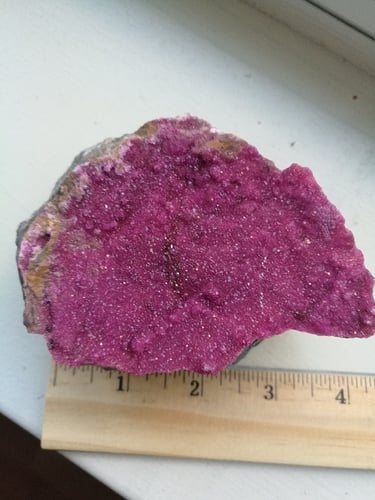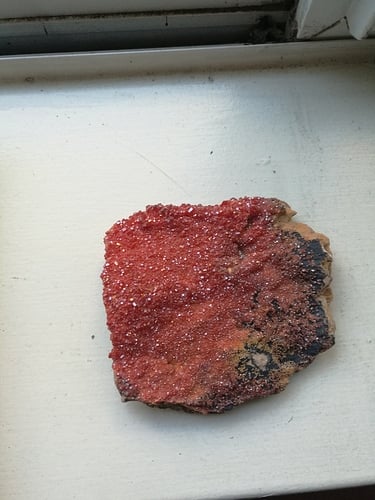Hi fellow jewelers,
This is my first post.
Does anyone have any advice on how to cut these delicate drusy stones? Can they handle the vibration of a trim saw? How close to the drusy can I cut? The Vanadenite seems like its on a bed of dry sedimentary clay. I am afraid water would make it disolve away.
I cut a lot of lapidary material, but never any druzy. You might try a small test piece first leaving as much of the base or matrix as possible. Another option would be to embed it in polyester epoxy to stabilize the material. Polyester epoxy cures hard and can be treated like lapidary material. It is expensive, but you can easily find it at AC Moore or Michaels. There isn’t a lot of lapidary discussion on this site. I would welcome more. Good luck…Rob
I’ve cut cobalto calcite without any problems. I use my flat lap and grind the back side flat then just put a bevel around the edge so it can be set in a bezel.
If your trim saw vibrates too much you might look at the blade. I’ve found cheap blades are just that, cheap. The better quality blades last longer and cut smoother.
I get my diamond blades from Kingsley North - kingslynorth.com
Rick
Thank you! I will try stabilizing the matrix first. I was thinking of cutting away most of the matrix (perhaps down to 10 mm), then having only the matrix soak in some sort of stabilizer. I am just afraid I might damage the drusies if I soak the whole piece under the stabilizer. Do you know how deep into the matrix the epoxy would penetrate? Can would I need to cover it up to prevent it from drying out before it has completely penetrated? Do I soak the piece? or simply brush on the epoxy? Thank you.
Thank you rockdewd! It’s good to know that Cobalto Caltcite can be trimmed down safely with a good diamond blade. I have worked with drusy quartz and have not had any problem. I just have no experience with the Cobalto and the Vanadenite.
I don’t really know how long you have to soak the matrix. I was suggesting embedding the material in polyester resin. Polyester resin cures very fast so you wouldn’t be soaking much. Other resins take longer to cure. Regardless of what resin you use, you may also need to use pressure. There is a lot of information online. All I can suggest is to experiment. Others may know a lot more about what you need to do than I…Rob
These stones are gorgeous as they are. It makes me nervous to try something for the first time. Following thus to see the result. Eventually i plan on wprking with geodes. Theres a store near my home/studio that has them. Im following this cause youre starting qith a raw piece and will end up with something amazing. My compliments to the chef.
Aaron
Few comments on your question…I doubt that water is going to dissolve the bedrock of this when you consider that it had to form in situ under a lot of heat and pressure in water, right? Secondly, would you really want to set something that is essentially secured by mud? Third, you are not going to find a lapidary saw that will cut this without requiring some kind of lubrication on the blade. Considering all this, take a shot at it with a trim saw and use an oil lube or water soluble lube specially for lapidary cutting, as this will prolong your blade life. Save the water for turquoise, which will absorb the oil. Here, even if your bedrock does absorb it, you won’t see it.
So take a trial cut at it with what you have, assuming your blade is running fairly true to avoid vibration and breakage. I do use a cheap, thin slitter blade on a 4 inch trim saw and it runs quite true and doesn’t destroy anything…after all, I’m cutting mostly facet rough and some soft turquoise. I use baby oil as a lube, leaves your hands smelling nice. Check to see whether this stuff is porous enough to absorb oil…just touch a little water to it and see if it goes in or lies on the surface. If it is porous, you might want to use water as a lube…goes in and comes out when it dries…If it does turn out that this stuff is fragile and tends to break in cutting, you could use a trim saw such as mine, which has variable speed from 4000 rpm down to a few hundred.
I haven’t cut any druzy, but I have never heard anything about it being particularly fragile, but this stuff is soft, so perhaps a gentle hand is needed and slow rpm. Let us know what happens! -royjohn
I’ve done a few stones that needed stabilization. 330 epoxy is what I’ve used. Mixed it up according to directions on you tube. Then put it in a plastic container with tight fitting lid. It soaked for about a week. Without pressure it will only soak/penetrate a small amount. But this all depends on what the firmness of the back material. If it is the consistency of loose fine dirt, I would soak it in water and get rid of most of that layer first. Then do the epoxy next. After that I build up the backing with black JB weld I think that’s the name of the stuff. You mix a small amount then press lightly the material on top so you are forming a new base. It’s what is done to thin turquoise to give it a nice hard stable backing. There are most likely many more ways to deal with it. This is just what I would do.
Aggie
Thank you for all your recommendations. I will trim off the blackened, less druzy area and test it out with the 330 epoxy that aggie.p suggested. I like your suggestion on washing out the “mud” on top first. Perhaps it’s just a top layer. Good suggestion.
Thanks aggie.p. I will try out stabilizing it first in a tightly sealed container and see what happens. I shall post my end results for all to see.

